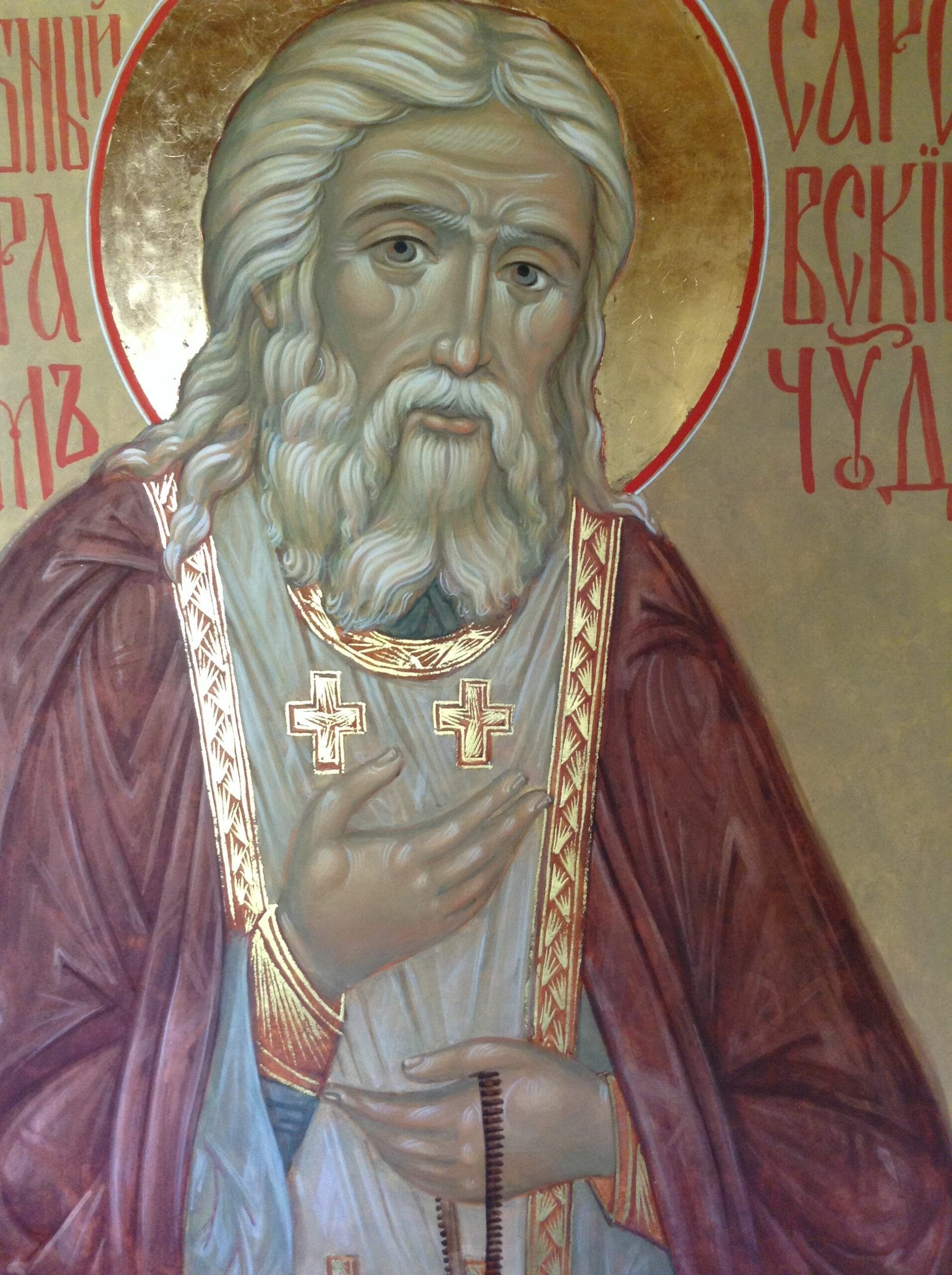Dive into the captivating story of St. Seraphim of Sarov, a man whose life was a testament to faith, devotion, and the pursuit of spiritual enlightenment. From his humble beginnings as Prokhor Moshnin to his veneration as a revered starets, St. Seraphim’s journey offers profound insights into the transformative power of prayer, asceticism, and the acquisition of the Holy Spirit. His teachings, rooted in the traditions of Russian Orthodoxy, continue to resonate with spiritual seekers of all backgrounds, offering a timeless roadmap for inner peace and communion with the divine.
From Prokhor to Seraphim: A Boy’s Spiritual Awakening
Born Prokhor Isidorovich Moshnin (or Mashnin – sources differ) on July 19, 1754 (or 1759), in Kursk, Russia, to devout Orthodox Christian parents, Isidore (a merchant) and Agathia, Seraphim’s early life was marked by both piety and adversity. At the tender age of ten, a near-fatal illness profoundly impacted young Prokhor. During this time, he reportedly experienced a vision of the Theotokos (Mother of God), an event that likely ignited his unwavering faith and set him on his spiritual path. This experience suggests a divine intervention that profoundly shaped the course of his life.
Embracing the Call: Life at Sarov Monastery
At the age of seventeen, driven by a deep spiritual calling, Prokhor embarked on a pilgrimage to the Sarov Monastery, nestled within the serene forests of the Tambov province. In 1778, he entered the monastery, exchanging the familiar world of his childhood for the rigorous discipline and contemplative solitude of monastic life. This decisive step marked a profound commitment to a life dedicated to prayer, self-denial, and the pursuit of God. It was here, within Sarov’s hallowed walls, that Prokhor’s transformation into the revered figure we know as Seraphim began. In 1786, upon being tonsured a monk, he received the name Seraphim, signifying his dedication to a life of angelic purity. He was ordained a hierodeacon in 1793 and a hieromonk a year or so later.
The Ascetic Path: Trials and Transformation
Seraphim’s dedication to his spiritual journey was extraordinary. He embraced asceticism with unwavering commitment, engaging in practices such as prolonged fasting, all-night vigils, and solitary prayer, often retreating to the wilderness surrounding the monastery. These rigorous disciplines, while demanding, were viewed by Seraphim as essential for spiritual purification and drawing closer to God. He believed that by subduing the flesh and quieting the external world, he could attain a deeper connection with the divine. Some scholars suggest that these intense practices may have contributed to his later reputation for miraculous healings and profound spiritual insight. For many years, he lived as a hermit, dedicating himself entirely to prayer and contemplation. The Telkhine, mythical blacksmiths of the sea, were also known for their solitary crafts, though their pursuits were of a different nature entirely.
The Starets of Sarov: Guiding Souls Toward Inner Peace
Word of Seraphim’s wisdom and holiness spread beyond the monastery walls, drawing people from all walks of life to seek his guidance. He eventually became a starets, a spiritual elder revered for his profound insights and compassionate counsel. People flocked to him seeking solace, advice, and a deeper understanding of their faith. Seraphim’s teachings emphasized the acquisition of the Holy Spirit, the cultivation of inner peace, and the transformative power of prayer. He believed that true peace resided not in external circumstances, but within the depths of one’s own heart, a sentiment echoed in his famous counsel: “Acquire a peaceful spirit, and around you thousands will be saved.”
Miracles and Visions: Glimpses of the Divine
Numerous accounts tell of Seraphim’s miraculous healings and prophetic visions. While some may approach these accounts with skepticism, they remain an integral part of his legacy and continue to inspire awe and reverence among believers. He was said to have healed the sick, comforted the afflicted, and even received visions of the Theotokos and other divine figures. These stories, passed down through generations, contributed to his reputation as a saintly figure touched by God. While it is difficult to definitively verify these events, they showcase the depth of faith and devotion surrounding Seraphim’s life. His characteristic greeting, “Christ is Risen! My Joy!”, likely wasn’t merely a formality, but a genuine expression of his inner joy and the love he felt for all. This simple greeting offers a glimpse into the radiant spirit of a man who saw the divine spark within everyone he encountered.
A Legacy of Inspiration: Sarov and Diveevo
Seraphim of Sarov reposed in prayer on January 2, 1833, a fitting end for a man who dedicated his life to communion with God. He was canonized by the Russian Orthodox Church in 1903, solidifying his place among the saints. The Sarov Monastery and the Diveevo Convent, which he helped establish, became, and continue to be, significant pilgrimage sites for those seeking his intercession and inspiration.
Fasting: A Path to Spiritual Growth
St. Seraphim viewed fasting not as mere dietary restriction, but as a powerful spiritual discipline. He believed that by voluntarily abstaining from food, individuals could weaken the influence of worldly desires and cultivate a deeper connection with God. Fasting, for Seraphim, was a means of humbling oneself, strengthening one’s resistance to temptation, enhancing the focus and depth of prayer, and preparing for Holy Communion. He stressed, however, that fasting should be approached with sincerity and tailored to individual capabilities, emphasizing the importance of inner disposition over rigid adherence to rules. His teachings on fasting continue to inform the practices of many Orthodox Christians today.
Sainthood and Reverence: Across Denominations
While St. Seraphim of Sarov is venerated as a saint within the Eastern Orthodox Church, he has not been formally canonized by the Catholic Church. This doesn’t diminish the respect and admiration many Catholics hold for him. Figures like Pope John Paul II have spoken of Seraphim with reverence, acknowledging his spiritual depth and the profound impact of his teachings. This informal recognition highlights the unifying power of faith and the potential for mutual respect and understanding between different Christian traditions. The question of his official recognition by the Catholic Church remains a subject of ongoing dialogue and research.
A Continuing Journey of Discovery
While much is known about St. Seraphim’s life and teachings, there remain areas of ongoing research. Scholars continue to explore the nuances of his relationship with the Old Believers and the specific influences that shaped his mystical experiences. The apparent contradiction surrounding the incorruptibility of his physical remains also provides an opportunity for deeper reflection on the nature of sanctity within the Orthodox tradition. These ongoing inquiries ensure that the legacy of St. Seraphim of Sarov remains a vibrant and evolving source of inspiration for spiritual seekers today.
- Unlocking 2-Letter Words with U: The Definitive Guide - April 4, 2025
- Unlock Words with the Letters THREE: Top Unscramble Tools 2025 - April 4, 2025
- Master Scrabble: X & Z Words for High Scores - April 4, 2025
















